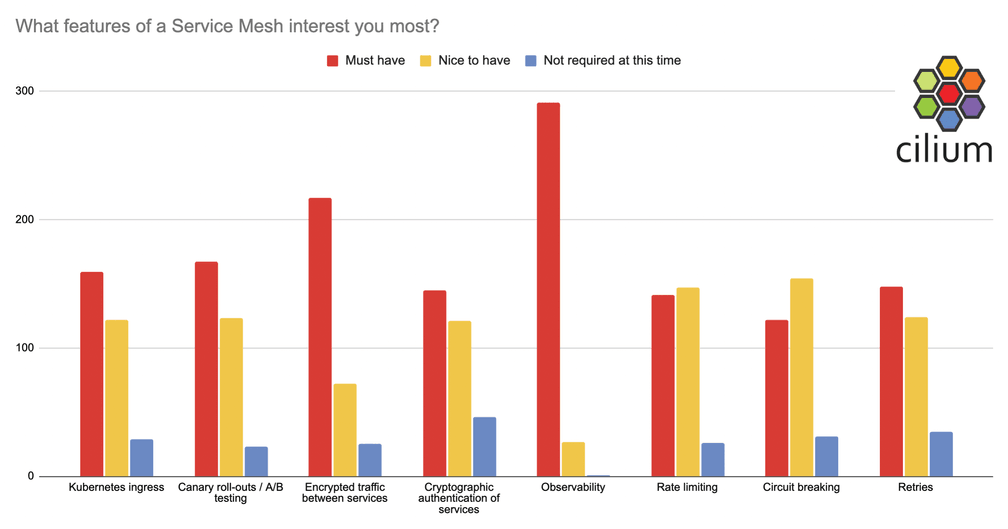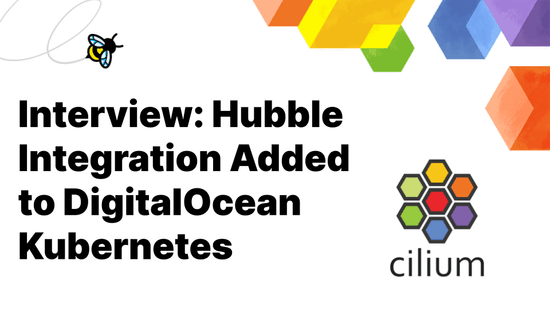Help prioritize Cilium Service Mesh features

Last month we kicked off beta testing for Cilium as an efficient data plane implementation for Service Mesh. Here’s an update on what we’ve learned so far, and some thoughts on next steps. If you’ve tried out the beta already we’d love your feedback in this short survey.
Who joined the beta so far?
We’ve had well over 300 responses to the Cilium Service Mesh Beta so far, with 65% of participants already using Cilium. (If you’re a production user and your organization is happy for this to be public knowledge, we’d love to see you make a PR to add yourself to the list of Cilium users!)
What features are most important?
The term “Service Mesh” covers many different features, and there’s not really industry-wide consensus on which of them are absolutely essential for something to call itself a service mesh - ask any vendor and they’ll tell you it’s the set of features their product offers! So we asked beta users what features they are most interested in.
Visibility is hands-down the most important feature, according to this survey, with 97% saying it’s a “must have” and not a single person responding that it’s unnecessary.
The second most-requested feature is traffic encryption, which over two-thirds say is essential. In the service mesh world this is often assumed to be implemented through mTLS (mutual TLS) between services, but mTLS provides not just encryption but also service authentication. The authentication aspect is seen as essential by a little under half of our beta users. Why doesn't everyone who needs encryption also need authentication at the service level? Well, if your requirement for traffic encryption is to ensure that it’s incomprehensible to a bad actor who managed to compromise your network, this can be achieved using transparent encryption (IPSec or WireGuard). But if you have legitimate services that are not all authorized to communicate with each other, an mTLS approach can make sense. mTLS requires L7 termination at the proxy, whereas transparent encryption happens within the network layer, so there is likely to be a performance tradeoff - we hope to bring you measurable benchmarks on that in the coming months.
The next most requested set of features feature is what we described in the survey as “Canary roll-outs / A/B testing”. These might also be termed “traffic splitting” or “load balancing”. At the moment in the service mesh beta we have an example of a configuration that splits traffic between two instances of a back-end service. This is achieved using a CiliumEnvoyConfig CRD, which exposes the raw configuration of the Envoy proxy instance. It seems highly likely that users will want a friendlier, higher level abstraction for this kind of configuration. We could extend Cilium to accept and understand control plane configurations that are already in existence, such as SMI, Istio or Linkerd CRDs - in fact, implementing support for one wouldn't rule out others in the future. Preliminary discussion in the #service-mesh-beta Slack channel suggests that SMI would be a popular option - what’s your view?
Kubernetes Ingress capabilities are required to get external traffic to your services, although whether you see them as inherently part of a service mesh or as a separate entity is a topic for debate. We have examples for HTTP and gRPC traffic ingress, including TLS support, as part of the beta.
The last group of features that folks are interested in with service mesh include rate limiting, retries and circuit breaking, with between a third and half of testers rating these as “must have”. Again, we’re really interested to hear your thoughts on the best way to configure these kinds of features, especially as these aren’t included in the SMI Spec. What’s your preferred way to control these features?
We also offered free-form text for people to tell us about other features they would like to see in a service mesh implementation, and a couple of suggestions stood out as popular.
-
Multi-cluster support was a popular response. Cilium already supports service routing across multiple clusters through Cilium Clustermesh, so it should be straightforward evolution for Cilium Service Mesh to be easily configured to run across multiple clusters.
-
Several people called out network policy support. This is another benefit of supporting service mesh capabilities from within the networking data plane - it’s natural to consider service-level network policies when designing how your service mesh should operate.
What’s next in the Cilium Service Mesh beta?
The biggest open question for Cilium Service Mesh is what the control plane should look like. So far we’re exposing raw Envoy configuration through the CiliumEnvoyConfig CRD, but we need more user-friendly approach, and (as mentioned above) there are several existing de-facto standards that it’s likely we could adopt and be compatible with.
There are several features already supported through Envoy, including mutual TLS support, and additional traffic management features like circuit breaking, that we’d like to make simpler to configure.
As well as consistency with pre-existing control plane configurations, there is work to be done to ensure RBAC controls for service mesh configuration.
There are several other goals in our near-term sights:
- One technical issue that came to light early on is that some of the examples need Cilium in tunnelling mode, so that’s being worked on right now.
- Cilium and Hubble export lots of powerful metrics to Prometheus and Grafana already, but we want examples specific to service mesh. For example, it should be easy to answer questions about service latency, and to provide the visibility that our beta users have strongly indicated they need.
- Helm chart configuration - the Cilium CLI is a great way to configure Cilium out of the box, but we want to give some Helm chart examples
- Performance benchmarks - the Isovalent team already shared some initial results on the gains made by removing sidecars, but for certain proof we want to design good tests that can be independently verified.
- Integrating TLS terminations for ingress with automated certificate management
Get involved!
We’d love to hear what you think should be added to Cilium Service Mesh over the coming months. The easiest way to participate is to answer our latest survey.
We’d welcome more example configurations in the beta repository, so if you have tried out some additional features, or used the service mesh with interesting sample apps, why not open a PR to share it with the community?
If you’d like to get involved with working on the code itself, we have a developer guide and we’d welcome you at the weekly developer call. And of course the Cilium & eBPF Slack channel is online 24/7 for your questions and comments! Join the #service-mesh-beta channel for discussions about these features.


